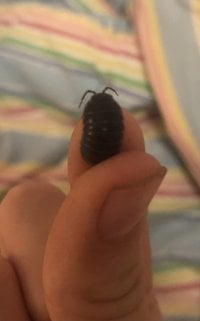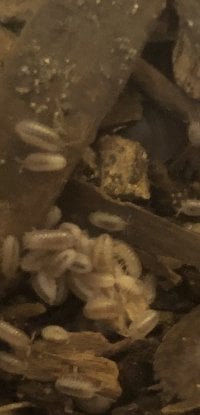J4ckdaw-
Sub-Adult Member
- Beardie name(s)
- Leo
Hi there 
The Isopod hobby is largely popular all over the world, in this guide I’ll be going over anything and everything you need to know before starting your own colony…
First of all… What is an isopod?
An isopod is an order of crustaceans that can inhabit both the land and water, the Rollie pollies you find crawling around in your backyard are a well known example of this:

What do I need to start a colony?
1) A Tupperware container or small aquarium
2) Organic topsoil
3) Sphagnum moss (sold at most herp shops)
4) Leaf litter
5) Bark and/or cork wood
6) Springtails/clean up crew
7) 10-20 sexually mature isopods
How do I set up an isopod habitat?
First of all, substrate;
To begin, crush up egg shells into a fine powder and mix it along with a small amount of reptile calcium powder (with or without D3) into the topsoil. Just like bearded dragons, isopods need a source of calcium!
Unless your topsoil comes premixed with some sort of decaying wood/wood chips, you’ll want to mix some of that in as well. I believe some stores sell it pre-packaged but you can get it from outside, wash it first!
Make sure your substrate is at least 2-3” deep to allow isopods to take part in natural behaviours such as burrowing! 2” I find is the bare minimum, even if you only have a small culture they will need more space quickly.
Cover the base substrate in leaf litter, it is best to buy this pre-packaged to reduce risk of bacteria or illness infecting your culture. Finally, add the sphagnum moss and spritz it with water until it is nice and wet.
Leave the other side of the substrate dry, this will cause the humidity gradient isopods need in order to thrive!
Secondly, decor;
Soak any bark or decor you will be putting in the habitat in a 50/50 vinegar and water solution for a few hours to kill off any unwanted bacteria or organisms, otherwise you might get some unwanted guests.
Place it to your liking, try and leave the side covered in moss bare since the higher humidity increases the likely hood of it to rot, grow mild, or some other fungal life. It isn’t always harmful but it’s better not to risk it.
Have fun decorating it with plants, rocks, animal skeletons (yes, skeletons! I keep a king fisher skull in mine!), and much more! Make sure it is all thoroughly cleaned first though!
Thirdly, the inhabitants;
If your isopods are store bought, they will likely be packaged in sphagnum moss to begin with! Carefully move the moss into your own habitat and spritz it with water as mentioned above to provide hydration.
If they are wild caught, you can move them from your temporary housing to their forever home by hand or any other way that works for you, if your hesitant about handling them put some moss in and let the climb on it.
As for the clean up crew, I personally use springtails. They eat what my isopods won’t (mold, fungus, droppings, etc…) but be careful! Since they are so tiny, they have very delicate bodies and are easy to squish!
What to expect in the first week?
Don’t expect much from your first week, even if you leave a feast out for them! It takes them a while to adjust, just like bearded dragons. Consider this isopod relocation stress, they will come out when they’re ready.
The three stages of life:
First there is the baby;
N/A
isopods at this stage are incredibly delicate and should not be handled at all. They take several months to become juveniles.
Second there is the juvenile;

Juveniles are the second stage of life of isopods, they are small but can be handled occasionally at this age. They become sexually mature at around this age.
Third there is the adult;

Adults are fully matured isopods who’ve reached their maximum size, they are easy to handle but fast! Watch out!
How do I breed my isopods?
Your isopods will breed on their own at their own pace, it may take several months until you see your first baby! Some morphs are much more prolific, for example dairy cows are known to reproduce incredibly quickly.
What does a gravid female look like?
This is what it will look like:

Sorry for the poor image quality, my phone’s camera sucks! The most obvious sign is visible eggs in her abdomen, they are circular and yellow. She will not lay them, in fact they will stay there until they hatch!
Heavily pregnant females such as this one have a bulgy white abdomen, that means the babies will be due any day now! Try not to handle them at this stage because it may cause her to be forced into labor!
What do I feed my isopods?
If your isopods have plenty of leaf litter and decaying wood to feast on, they do not need to be fed. You can offer fresh fruit, Repashy Detrivore gel, fish flakes, wet dog food, or even reptile shed as food as well!
Do I mist my isopods?
Yes, but not as much as you’d think. Keep the mossy side nice and wet while the other side is dry. You can simulate rainy weather by lightly spritzing the entire habitat every so often but not more than once a week.
Let me know if you have any questions or if there is any topics I should add, for now that’s about it! Hope this helped at all!
The Isopod hobby is largely popular all over the world, in this guide I’ll be going over anything and everything you need to know before starting your own colony…
First of all… What is an isopod?
An isopod is an order of crustaceans that can inhabit both the land and water, the Rollie pollies you find crawling around in your backyard are a well known example of this:
What do I need to start a colony?
1) A Tupperware container or small aquarium
2) Organic topsoil
3) Sphagnum moss (sold at most herp shops)
4) Leaf litter
5) Bark and/or cork wood
6) Springtails/clean up crew
7) 10-20 sexually mature isopods
How do I set up an isopod habitat?
First of all, substrate;
To begin, crush up egg shells into a fine powder and mix it along with a small amount of reptile calcium powder (with or without D3) into the topsoil. Just like bearded dragons, isopods need a source of calcium!
Unless your topsoil comes premixed with some sort of decaying wood/wood chips, you’ll want to mix some of that in as well. I believe some stores sell it pre-packaged but you can get it from outside, wash it first!
Make sure your substrate is at least 2-3” deep to allow isopods to take part in natural behaviours such as burrowing! 2” I find is the bare minimum, even if you only have a small culture they will need more space quickly.
Cover the base substrate in leaf litter, it is best to buy this pre-packaged to reduce risk of bacteria or illness infecting your culture. Finally, add the sphagnum moss and spritz it with water until it is nice and wet.
Leave the other side of the substrate dry, this will cause the humidity gradient isopods need in order to thrive!
Secondly, decor;
Soak any bark or decor you will be putting in the habitat in a 50/50 vinegar and water solution for a few hours to kill off any unwanted bacteria or organisms, otherwise you might get some unwanted guests.
Place it to your liking, try and leave the side covered in moss bare since the higher humidity increases the likely hood of it to rot, grow mild, or some other fungal life. It isn’t always harmful but it’s better not to risk it.
Have fun decorating it with plants, rocks, animal skeletons (yes, skeletons! I keep a king fisher skull in mine!), and much more! Make sure it is all thoroughly cleaned first though!
Thirdly, the inhabitants;
If your isopods are store bought, they will likely be packaged in sphagnum moss to begin with! Carefully move the moss into your own habitat and spritz it with water as mentioned above to provide hydration.
If they are wild caught, you can move them from your temporary housing to their forever home by hand or any other way that works for you, if your hesitant about handling them put some moss in and let the climb on it.
As for the clean up crew, I personally use springtails. They eat what my isopods won’t (mold, fungus, droppings, etc…) but be careful! Since they are so tiny, they have very delicate bodies and are easy to squish!
What to expect in the first week?
Don’t expect much from your first week, even if you leave a feast out for them! It takes them a while to adjust, just like bearded dragons. Consider this isopod relocation stress, they will come out when they’re ready.
The three stages of life:
First there is the baby;
N/A
isopods at this stage are incredibly delicate and should not be handled at all. They take several months to become juveniles.
Second there is the juvenile;
Juveniles are the second stage of life of isopods, they are small but can be handled occasionally at this age. They become sexually mature at around this age.
Third there is the adult;
Adults are fully matured isopods who’ve reached their maximum size, they are easy to handle but fast! Watch out!
How do I breed my isopods?
Your isopods will breed on their own at their own pace, it may take several months until you see your first baby! Some morphs are much more prolific, for example dairy cows are known to reproduce incredibly quickly.
What does a gravid female look like?
This is what it will look like:
Sorry for the poor image quality, my phone’s camera sucks! The most obvious sign is visible eggs in her abdomen, they are circular and yellow. She will not lay them, in fact they will stay there until they hatch!
Heavily pregnant females such as this one have a bulgy white abdomen, that means the babies will be due any day now! Try not to handle them at this stage because it may cause her to be forced into labor!
What do I feed my isopods?
If your isopods have plenty of leaf litter and decaying wood to feast on, they do not need to be fed. You can offer fresh fruit, Repashy Detrivore gel, fish flakes, wet dog food, or even reptile shed as food as well!
Do I mist my isopods?
Yes, but not as much as you’d think. Keep the mossy side nice and wet while the other side is dry. You can simulate rainy weather by lightly spritzing the entire habitat every so often but not more than once a week.
Let me know if you have any questions or if there is any topics I should add, for now that’s about it! Hope this helped at all!
Attachments
Last edited:


